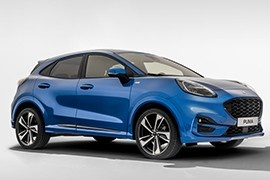
FORD Puma
Generations Timeline, Specs and Pictures

The name is old, this car is new and has high-hopes on the ever-expanding crossover market.
It is meant to be loved by those who, 20 years ago, were teenagers and loved that little sport-coupe car from Ford. Except that, this time, the Puma is a crossover built in Eastern Europe after a 1.8 billion dollars investment, not a compact sports car built in Germany.
Like the old Puma, which introduced a new design language (new-edge design), the new Puma starts a new generation of Ford electrified vehicles. It features a 48-volt architecture and it is a mild-hybrid with underfloor batteries.
The new Ford Puma will have only one engine: the 1.0-liter EcoBoost with three cylinders and three power versions, starting with a 125 hp (same as the original Puma) and ending with a 155 hp version. Except for the base model, all the other trim levels will have a mild-hybrid function.
The small, 4.2m (13.7 ft) crossover Puma is able to carry 456 liters (16 cu-ft) of luggage. But don’t expect something extraordinary from the available passenger space. Five people will fit inside, but not for the longest drive of your life. Those who will share the backseat are not going to be very happy after a 2-hour drive.
The new Puma also introduces the newest Ford infotainment system, SYNC 3. The system allows users to keep their phone in the wireless charging point, while they can browse or listen to music uninterrupted.

The Ford Puma was a strong competitor on the small coupe market.
Sharing the chassis with the smaller Fiesta, the Puma was longer and the steering and handling were improved to offer a great sporty experience.
Ford worked hard on designing the Puma and they managed to achieve a distinctive look that turned many heads.
From the front, the Puma had an aggressive look, with the beautifully designed headlamps, while from the back, each stoplight had 3 lights that perfectly matched the sporty nature.
Aggressively marketed, the Puma reached the hearts of the young buyers, which was exactly the target market.
Ford’s aim was to create a car with exceptional performance and a unique design.
The Puma was available with 4 different engines: 1.4-liter with 90 hp, 1.6-liter with 103 hp, 1.7-liter with 1.7 and the most powerful, the 1.7-liter Ford Racing Zetec-SE that developed 155 hp.
As not only the ponies under the hood matter for great performance, the small coupe weighed around 1,040 kg, thus the Puma had a quick response to acceleration.
With the 1.7-liter engine, the Puma would accelerate to 100 kph in around 8.6 seconds and from 48 to 112 km/h in 8.8 seconds.























































